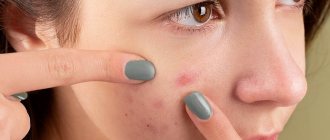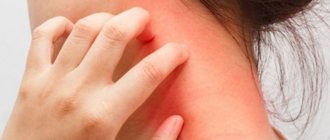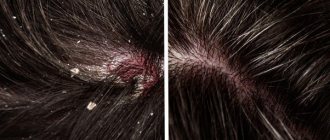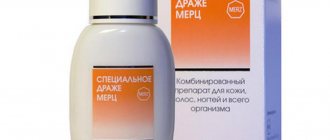Allergy on the face in the form of red spots is a common problem with which patients often turn to dermatologists. To clarify the exact cause of this condition most often requires time and a number of additional studies. To alleviate the condition of allergic dermatitis, modern antiallergic drugs are used, which include Cetrin.
Symptoms
It is quite easy to suspect an allergic reaction in yourself or your child. In addition to the presence of an allergic rash on the face, the following complaints are noted:
- Severe itching or burning;
- Dryness, flaking of the skin;
- Swelling of the eyelids, lips;
- lacrimation;
- Itching and redness of the eyes.
The rash itself may be in the form of red spots or blisters filled with transparent contents. Sometimes an allergic rash looks like small grouped dots that rise above the surface of the skin. If the rash appears after consuming any product, then symptoms may include nausea, vomiting, diarrhea, and abdominal pain1.
Color of the skin
Look to see if any changes have appeared on your face, such as swelling or hyperpigmentation. Skin color is very important in assessing health.
Straw color.
If you have a straw complexion, you need to do a biochemical blood test. The symptom often signals a vitamin B12 deficiency.
B12 deficiency is obvious if a set of symptoms is present:
- lips have a straw tint;
- epigastric pain occurs;
- there is a burning sensation of the tongue;
- depression is present.
B12 deficiency can be expressed not only by a discolored complexion, but also by other symptoms.
Gray complexion.
A grayish tint to the face appears in people with chronic lung disease and in smokers. However, in the latter, chronic lung pathology occurs most often.
Smokers should regularly undergo spirometry testing to diagnose the disease. And if your skin color has taken on a gray tint, you need to get checked immediately.
Paleness of the skin.
Pale facial skin indicates anemia or low blood pressure. The condition is especially noticeable with temporary drops in pressure.
Redness.
If the face turns red, this may indicate pressure surges. When it comes to experiencing strong emotions, the problem is temporary and does not pose a danger.
With constant redness of the face with simultaneous redness of the conjunctiva, a comprehensive diagnosis is required, including a set of specialized cardiological studies. Such symptoms are caused by vascular diseases and heart problems.
But redness in the form of symmetrical spots on the nose and cheeks, resembling the shape of a butterfly, is one of the initial manifestations of lupus, one of the most dangerous and formidable kidney diseases.
Hyperpigmentation spots
. If the spots are brown and appear randomly, mainly on the forehead and cheeks, these are rather symptoms of impaired liver function. A blood test should be done for so-called liver tests.
In this case, it is recommended to exclude from the diet:
- coffee and alcohol;
- fats;
- spicy spices;
- foods with saturated and trans fats.
If the spots are symmetrical and appear on the upper lip, then the condition often indicates hormonal disorders.
Causes
The main reasons for the appearance of red spots on the skin of the face:
- Direct skin contact with an allergen (cream, face mask, decorative cosmetics, soap, jewelry, etc.);
- Food allergies;
- Allergy to medications;
- Allergy to sun or cold;
- Eczema1.
To prevent the appearance of a rash in the future, it is necessary to accurately determine the cause of the allergy and eliminate contact with this substance.
Nodular pathologists
The causative agent of erythema nodosum is usually streptococcus, and less often - some other infections. It often occurs against the background of tonsillitis, scarlet fever, and tuberculosis. You can recognize it by the following signs:
- rashes of bright red color, with bulges forming in the subcutaneous layer;
- asymmetrically located spots;
- gradual bluing of the spots, then yellowing, similar to the resorption of bruises;
- presence of fever;
- painful sensations and itching in the affected areas of the skin;
- the presence of multiple seals on the legs.
The patient is prescribed a course of antibiotics, antihistamines, as well as external treatment with antiseptics.
Contact dermatitis
Contact dermatitis rashes are most often localized on the hands or face. An allergic reaction can be triggered by:
- Skin care products. It is important to pre-test creams, masks, lotions and other new products by applying a small amount of product to the inner surface of the forearm for 15-20 minutes.
- Decorative cosmetics. Contains a large number of coloring pigments, fragrances and preservatives. People with sensitive skin prone to dryness and irritation are more prone to allergic reactions.
- Plant pollen. When pollen from plants to which a person is allergic comes into contact with the skin, a rash, itching and other unpleasant symptoms may appear.
Red spots may appear either immediately after contact with the allergen or after some time (usually within 24-48 hours). If you find the cause of the allergy in time and stop using the inappropriate product, then no negative health consequences will be noted.
Facial swelling
A slight swelling of the facial tissues, which persists constantly, most often indicates the initial stage of an endocrine disease - hypothyroidism. Pigmentation quickly disappears after taking thyroid hormone - thyroxine.
Mild and persistent swelling of the face, which is accompanied by shortness of breath and swelling of the legs, usually in the ankles, as well as frequent getting up at night to go to the toilet, indicates circulatory failure and poor heart function.
When swelling of the face is accompanied by pallor, and visits to the toilet are very frequent, but urination is scanty, kidney disease can be suspected.
It is very dangerous when fluid accumulates only in the upper lip. If the swelling is accompanied by a feeling of tightness in the chest, difficulty breathing, then this is an allergic reaction - Quincke's edema!
The condition can become a serious threat to life. In this case, an ambulance is needed.
Allergies to foods and medications
Food allergies on the face are quite common, especially in children. The most allergenic foods are peanuts, eggs, seafood, citrus fruits, and dairy products. However, in the presence of individual intolerance, an allergy can develop to any other food product.
Main symptoms:
- blotchy rash on the face or body;
- Severe itching;
- Peeling of the skin;
- Nausea, vomiting;
- Stool disorders;
- Abdominal pain.
Another important problem is drug allergies. An allergic reaction may occur to a medicine in the form of a tablet, injection, or ointment. Allergies to antibiotics, antiseptics, and nonsteroidal anti-inflammatory drugs are common. The symptoms are the same as those of a food allergy. In severe cases, complications such as angioedema or anaphylactic shock may develop2. You need to know what drugs you are allergic to and warn doctors or medical staff about it.
How to diagnose allergies
The main difficulty is to distinguish it from a skin disease. Rashes should not be a reason for panic, but a prerequisite for examination. To prevent exacerbation and speed up the process of identifying causes, it is necessary:
- try to independently identify the allergen by eliminating cosmetics or products from everyday use, doing this gradually in order to replace the changes in time;
- take an antihistamine that has already been used as prescribed by a doctor;
- Remove all alcohol-based external care products from use.
After such measures, it will be much easier to determine how to relieve an allergic reaction on the face and alleviate the general condition.
We recommend
GHC Placental 3D Mask withQ10
Serum concentrate
Repairing cream with a moisturizing effect
Placental antioxidant lotion concentrate
Allergy to sun or cold
Natural factors can also cause the development of allergic reactions. Photoallergy or sun allergy most often occurs in the warm season - from late spring to early autumn. Sometimes an allergic rash is confused with sunburn, but the allergic nature of the disease is characterized by severe itching, the appearance of small, white pustules, and spotty red rashes even after a short stay in the open sun. In such cases, you need to apply sunscreen, protect exposed skin with clothing made from natural fabrics, and wear a hat3.
Allergy to cold or cold urticaria also occurs. During the cold season, red itchy rashes, peeling, and a feeling of tightness appear on the skin of the face and hands. Symptoms may persist for several hours or several days after exposure to the cold. Typically, allergies develop at temperatures from 10 degrees below zero, but it also happens at temperatures close to zero.
Infectious pathologies
Various pathogens can provoke the development of infectious inflammation of the skin - bacteria, fungi, viruses or parasites. This form is characterized by an acute course, which can turn into a chronic form. The patient needs immediate medical attention.
In its acute form, the most common erythema infectiosum in children is caused by parvovirus B19. It is characterized by the sudden onset of the disease, the characteristic signs of which are:
- rapidly rising body temperature;
- muscle pain, headache;
- the appearance of a red rash covering the face and body on the third or fourth day after the onset of the disease;
- gradual increase and closure of spots.
After some time, clinical manifestations gradually fade away until they disappear completely. If left untreated, the process can become chronic. The patient remains able to transmit the infection to healthy people for several days after recovery.
Eczema
Eczema is an inflammatory skin disease that tends to be chronic and relapsing. Often the symptoms of eczema are confused with allergic reactions, since the rashes can be similar in appearance. Eczema is characterized by the appearance of bright red spots and swelling of the skin. Grouped bubbles with transparent contents appear on a red background, after which crusts form.
The occurrence of the disease is associated with mechanical damage to the skin, microbial or fungal infection, and occupational hazards. Complex immune reactions characteristic of allergies also take part in the development of pathology.
Atopic dermatitis and its differences from psoriasis
Atopic dermatitis may also cause dry patches to appear on the body. And as with psoriasis, they cause itching. Due to the increased sensitivity of the skin to environmental factors, the mechanisms of its self-regulation are disrupted, including the barrier function. That is, the trigger for atopic dermatitis is an allergy, but the tendency to such a skin reaction is genetically determined.
Most often, atopic dermatitis occurs in children. The disease has a chronic course, when exacerbations are replaced by periods of remission. Here are the typical signs of atopic dermatitis:
- dry skin;
- peeling and redness of the eyelids;
- dry flesh-colored plaques on the trunk and extensor areas of the body;
- cracks.
It is difficult for a person without medical education to distinguish psoriasis from atopic dermatitis, but a doctor can easily make a differential diagnosis. There are several differences that may speak in favor of one or another pathology. Atopic dermatitis most often affects children, psoriasis can debut in adulthood. Psoriatic plaques are raised above the skin, and scales can be seen. Dry spots in atopic dermatitis are flat. It is also important to consider the typical location.
Useful links: State Center of Urology in Moscow - Clinic of Urology named after R. M. Fronshtein of the First Moscow State Medical University named after I.M. Sechenov
Treatment
Treatment for facial allergies must include a safe and effective antihistamine3. Cetrin is widely used for seasonal allergies and various forms of allergic dermatitis. The main active ingredient of the drug is cetirizine hydrochloride, which is a histamine antagonist. The advantages of the drug include:
- Quick effect. Onset of action 20 minutes after administration.
- Duration of action. The drug is taken once a day and is effective for 24 hours.
- Good tolerance. Cetrin is well tolerated by patients and causes less drowsiness than first-generation drugs1.
The drug helps eliminate itching, swelling, and redness of the skin. Available in tablet form, approved for use in children over 6 years of age. If you suspect an allergic rash, taking Cetrin is a simple, safe way to make you feel better before you can see a doctor.
Types of pathology
Erythema is classified according to the type of vessels affected:
- active - occurring with a sharp expansion of the lumen of arterial vessels, accompanied by an acute inflammatory process, with bright redness of the skin, increased temperature, swelling and soreness of the skin;
- passive - formed when blood stagnates in the venous vessels during their expansion, accompanied by the appearance of bluish-red or burgundy spots, mainly accompanying inflammation with a chronic course.
Each variety is caused by different causative factors and requires a separate therapeutic approach.
Based on etiology, the following types of erythema are distinguished:
- non-infectious - which are the physiological reaction of the body to external or internal irritants (solar ultraviolet radiation, critically high or low temperature, allergens, etc.);
- infectious - caused by the penetration of infection into the skin capillaries through the surface of the epidermis, from the systemic bloodstream or through the mucous membrane.
Non-infectious manifestations usually do not require special treatment, as they go away on their own after the action of the provoking factor ceases. Infectious reactions are expressed in an inflammatory process that occurs in an acute or chronic form and is accompanied by certain symptoms.








